Day 8: Half Hitch
Many complex hitches use the half hitch as a building block. We used it as a friction in Day 2 and combined it into a lock in Day 4. Because of its simplicity, the half hitch is a powerful tool to create structure and beautiful patterns. A series of half hitches on a limb form a quick ladder tie, and using it to change direction creates a zig-zag pattern. Looking at its use in macrame and knitting is very inspiring to create new ties.
Half Hitch
Half hitches are a great way to add structure to a tie but it requires maintained tension in order to keep its grip.
Here we are using the half hitch as described in ABOK 2490. For more knot geeking, the Ashley Book of Knots is an excellent resource to explore the different variations and combinations of this hitch and many others.
Zig Zag Strappado
A strappado is a tie that brings the two arms parallel in the back. It is also known as armbinder. This is a great way to try both the ladder structure and the zig-zag pattern.
When tying on the arms, make sure the rope is slightly loose to avoid nerve compression. For most people, this arm position will be hard to maintain, be ready to untie quickly if needed.
We’ll look into more strappado ties in Day 105.
Dreamcatcher Leg Tie
Dreamcatchers are an amazing inspiration, this Native American tradition has a huge variety of beautiful patterns to study. The classic basic pattern only uses half hitches and is quite easy to tie.
Practice Time!
Create a tie with a zig-zag or dreamcatcher pattern to drill half hitches in different directions.
Self-evaluation checklist:
- There are no unnecessary twists in the rope
- The rope folds in a way that makes the half hitches folded for maximum efficiency
- Maintain equal tension across the tie. Anticipate tension change as catching a previous rope and pulling will progressively add tension
Exploration ideas:
- Try the patterns on different body parts
- Try the patterns on an inanimate object such as a chair or a frame
- Compare half hitches vs just going straight (not catching on itself, for the same tie design)
- How does the tie behave when moving the limbs after they were tied?
- Look at different macrame and dreamcatcher patterns and try them on the body
|
Being Tied: Holding the Pattern – sansblague This half hitch can be used to make shapes that look beautiful – as long as you stay in one specific position with your body. Since the pattern is made in the space between your limbs, it would be easy for you to destroy it by moving your arms closer to each other, bending them or wiggling your way out of the cuffs on your upper arms. In this case, you will need to hold still and let the situation be your bondage if you want your partner to be able to practice. |
Inspirations and Resources
Coming soon!
Credit:Half hitch R/P: Ebi McKnotty. Zig zag armbinder M: Nathaniel Flumen R/P Ebi McKnotty. Dreamcatcher leg tie M/R: FreakyFerret P: Ebi McKnotty
Or return to Hitches for more options.

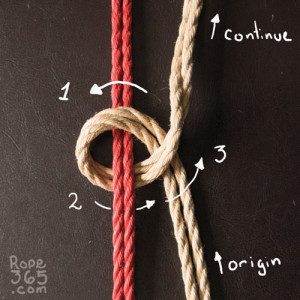
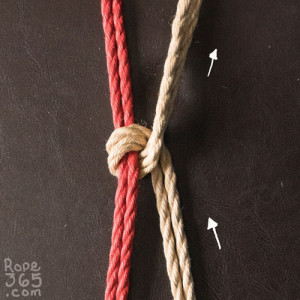
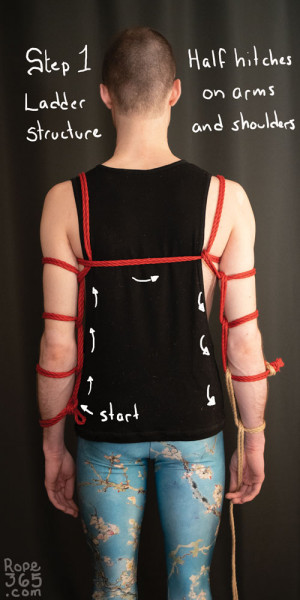
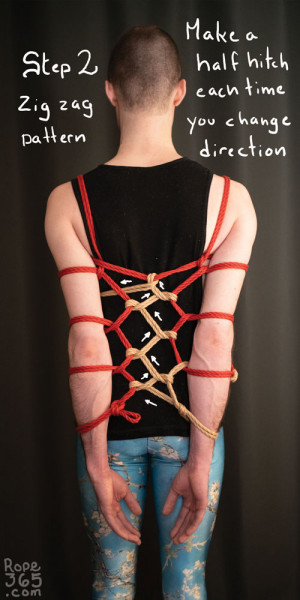
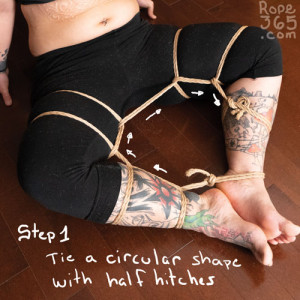
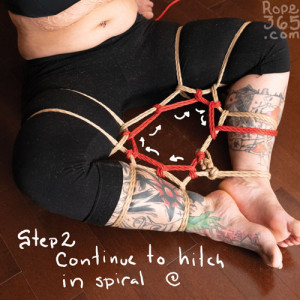
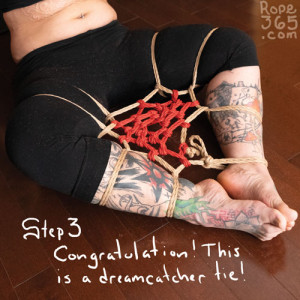
2024-05-14 at 5:42 PM
Hi Ebi,
I am new to rope, was reccommended your site, and so far its a fabulous resource. Thank you for all the hard work you’ve put in. I’m commenting because I feel uncomfortable about your use of the dream catcher and I am hoping to have some open dialogue around this. As you may or may not know, the dream catcher is a item of great significance to many different indigeneous groups, and also one that is frequently appropriated, stolen, misused, and disrepected. I am a non-indigenous settler in so called canada, and I do my best to decolonize my life and learn continously while living on stolen land – so I am not an authority and not writing this as an accusation. My understanding is that it is okay for non-indigeneous people to purchase and display dream catchers so long as you support indigenous artists, and are culturally respectful with it. Given that many indigeneous groups across Turtle Island continue to struggle to access basic necessities such as clean water and housing, I feel that calling your leg rope design a dream catcher is perhaps not the most culturally sensitive. Rope bondage is pretty far removed from the original context of the dream catcher, and the use of that imagery here is not done as any particular cultural celebration. I am hoping that you will reflect on this and maybe consider renaming your design as spiderweb leg tie, or something similar. Tried to keep this as brief as possible, thanks for your time and I hope this leads to futher discussion of decolonization for you and other readers 🙂
2024-08-14 at 8:28 AM
Hi, thank you for your concern. The person self-tying the tie in the picture is Freaky Ferret of the Wabanaki nation. She has a personal relationship with dream catcher through her family craft. We discussed adding a writing of her about the meaning of dreamcatchers but she is allowed to do that on her own time. Meanwhile you can follow her work on instagram and I also recommend the First Nation hook Kollectiv that she co-founded.
https://www.instagram.com/freaky_ferret/
https://www.instagram.com/fnhk_hooks/
I will continue to reflect on the name of the tie. I believe it’s important to mention that this was inspired by dreamcatchers and honouring this. Erasing where the inspiration comes from would feel disrespectful to the original craft.
2024-07-12 at 7:55 AM
Der Traumfänger vergleich ist großartig und ich, als betroffene Person, bin damit voll zufrieden. Ich hoffe, hier wird nicht über Politik diskutiert, sondern weiterhin nur über Seilkunst. Liebe Grüße